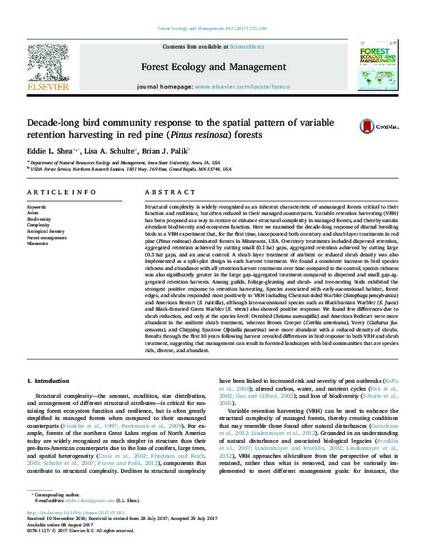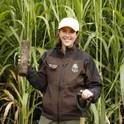
Structural complexity is widely recognized as an inherent characteristic of unmanaged forests critical to their function and resilience, but often reduced in their managed counterparts. Variable retention harvesting (VRH) has been proposed as a way to restore or enhance structural complexity in managed forests, and thereby sustain attendant biodiversity and ecosystem function. Here we examined the decade-long response of diurnal breeding birds to a VRH experiment that, for the first time, incorporated both overstory and shrub layer treatments in red pine (Pinus resinosa) dominated forests in Minnesota, USA. Overstory treatments included dispersed retention, aggregated retention achieved by cutting small (0.1 ha) gaps, aggregated retention achieved by cutting large (0.3 ha) gaps, and an uncut control. A shrub layer treatment of ambient or reduced shrub density was also implemented as a split-plot design in each harvest treatment. We found a consistent increase in bird species richness and abundance with all retention harvest treatments over time compared to the control; species richness was also significantly greater in the large gap-aggregated treatment compared to dispersed and small gap-aggregated retention harvests. Among guilds, foliage-gleaning and shrub- and tree-nesting birds exhibited the strongest positive response to retention harvesting. Species associated with early-successional habitat, forest edges, and shrubs responded most positively to VRH including Chestnut-sided Warbler (Setophaga pensylvanica) and American Restart (S. ruticilla), although late-successional species such as Blackburnian Warbler (S. fusca) and Black-throated Green Warbler (S. virens) also showed positive response. We found few differences due to shrub reduction, and only at the species level: Ovenbird (Seiurus aurocapilla) and American Redstart were more abundant in the ambient shrub treatment, whereas Brown Creeper (Certhia americana), Veery (Catharus fuscenscens), and Chipping Sparrow (Spizella passerina) were more abundant with a reduced density of shrubs. Results through the first 10 years following harvest revealed differences in bird response to both VRH and shrub treatment, suggesting that management can result in forested landscapes with bird communities that are species rich, diverse, and abundant.
Available at: http://works.bepress.com/lisa_schulte/77/

This article is published as Shea, Eddie L., Lisa A. Schulte, and Brian J. Palik. "Decade-long bird community response to the spatial pattern of variable retention harvesting in red pine (Pinus resinosa) forests." Forest Ecology and Management 402 (2017): 272-284. doi:10.1016/j.foreco.2017.07.053.